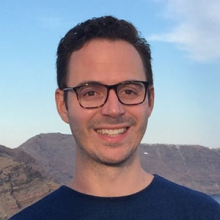-
Title
Staff Scientist -
Email
mccartt1@llnl.gov -
Phone
(925) 422-7614 -
Organization
Not Available
Research Interests
Daniel McCartt works at LLNL’s Center for Accelerator Mass Spectrometry (CAMS) developing laser-based spectroscopic methods. CAMS leverages AMS’s ability to detect rare isotopic species to perform incredible science. He is currently developing a cavity ring-down spectroscopy (CRDS) instrument for the detection of carbon-14. The measurement of carbon-14 with accelerator mass spectrometer is often cost prohibitive due to the substantial investment required in both facilities and technically proficient staff. A more affordable carbon-14 CRDS would enable the proliferation of powerful carbon-14 scientific applications such as micro-dose drug testing and anthropogenic carbon cycle monitoring. The current prototype is capable of sub-contemporary carbon-14 measurements and is suitable for use in biological studies.
Patents
US 9,645,077, May 5, 2017, Titled: “Optical spectrometer for analysis of carbon-14, computes carbon-14 concentration from detector signal, and provides spectroscopic model to account for contributions from interfering species that interfere with carbon-14,” by T. Ognibene, G. Bench, A.D. McCartt, K. Turteltaub, C.W. Rella, S. Tan, J.A. Hoffnagle, N. Saad, and E. Crosson.
PhD, Mechanical Engineering, Stanford University, 2014
MS, Mechanical Engineering, Stanford University, 2009
BS, Mechanical Engineering, Duke University, 2007
A. D. McCartt, T. J. Ognibene, G. Bench, and K. W. Turteltaub (2016). “Quantifying Carbon-14 for Biology Using Cavity Ring-Down Spectroscopy,” Analytical Chemistry 88(17):8714–8719.
A. D. McCartt, T. J. Ognibene, G. Bench, and K. W. Turteltaub (2015) “Measurements of carbon-14 with cavity ring-down spectroscopy,” Nucl. Instrum. Methods Phys. Res. B 361:277–280.
A. D. McCartt, T. J. Ognibene, G. Bench, and K. W. Turteltaub (2014). “Model-based, closedloop control of PZT creep for cavity ring-down spectroscopy,”. Measurement Science and Technology 25(9), 095201.
A. D. McCartt (2014) “Development of a low-temperature cavity ring-down spectrometer for the detection of carbon-14,” Stanford University.
A. D. McCartt, Gates, S. D., et al. (2012). “In situ Optical Measurements of Bacterial Endospore Breakdown in a Shock tube,” Applied Physics B: Lasers and Optics 1–6.
A. D. McCartt, Gates, S. D., et al. (2011). “Response of Bacillus thuringiensis Al Hakam endospores to gas dynamic heating in a shock tube,” ZPC 225,1367–1377.
S. D. Gates, A. D. McCartt, et al. (2011) “Extension of Bacillus endospore gas dynamic heating studies to multiple species and test conditions,” Journal of Applied Microbiology 111(4): 925–931.
S. D. Gates, A. D. McCartt, et al. (2010) “Bacillus endospore resistance to gas dynamic heating,” Journal of Applied Microbiology 109(5): 1591–1598.
Selected Presentations
2017, “Making Carbon-14 Measurements More Accessible,” Monterey Bay Aquarium Research Institute Seminar (Monterey, USA)
2017, “14C-labeled, biological-sample measurements by cavity ring-down spectroscopy: Detection method, sample automation, and comparison to AMS,” 14th International Accelerator Mass Spectrometry Conference (Ottawa, Canada)
2017, “Automation of 14C-labeled, biological-sample measurements by cavity ring-down spectroscopy and comparison to accelerator mass spectrometry,” 253rd American Chemical Society National Meeting & Exposition (San Francisco, USA)
2016, “Harnessing the Building Block of Life: Using Carbon-14 to Monitor Fossil Fuel Emissions,” LLNL ResearchSlam! 3 minute speech competition (3rd Place) (California, USA)
2016, “Quantifying Carbon-14 with Cavity Ring-Down Spectroscopy for Biology,” LLNL Physical and Life Sciences Postdoc Seminar Series (Livermore, USA)
2014, “Quantification of 14C with Cavity Ring-Down Spectroscopy,” The Thirteenth International Conference on Accelerator Mass Spectrometry (Aix en Provence, France)
2009, “In Situ Optical Measurements of Shock Wave Interactions with Endospore-Laden Bioaerosols,” Chemical and Biological Defense Science and Technology Conference (Dallas, USA)


